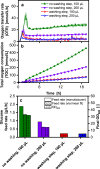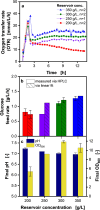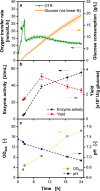Small-scale fed-batch cultivations of Vibrio natriegens: overcoming challenges for early process development
- PMID: 40249449
- PMCID: PMC12089209
- DOI: 10.1007/s00449-025-03159-9
Small-scale fed-batch cultivations of Vibrio natriegens: overcoming challenges for early process development
Abstract
Vibrio natriegens is a fast-growing microbial workhorse with high potential for biotechnological applications. However, handling the bacterium in batch processes is challenging due to its high overflow metabolism and mixed acid formation under microaerobic conditions. For early process development, technologies enabling small-scale fed-batch cultivation of V. natriegens Vmax are needed. In this study, fed-batch cultivations in 96-well microtiter plates were successfully online-monitored for the first time with a µTOM device. Using the online-monitored oxygen transfer rate, a scale up to membrane-based fed-batch shake flasks was performed. The overflow metabolism was efficiently minimized by choosing suitable feed rates, and mixed acid formation was prevented. A glucose soft sensor using the oxygen transfer rate provided accurate estimates of glucose consumption throughout the fermentation, eliminating the need for offline sampling. Analyzing the impact of the inducer IPTG on the recombinant production of the enzyme inulosucrase revealed concentration-dependent effects in batch processes. In contrast, fed-batch operating mode resulted in high inulosucrase activity even without induction. Overall, an inulosucrase titer of 80 U/mL was achieved. In conclusion, the advantages of small-scale fed-batch technologies supported by a glucose soft sensor have been demonstrated for early process development for V. natriegens Vmax.
Keywords: Vibrio natriegens; Fed-batch; Glucose soft sensor; Microtiter plate.
© 2025. The Author(s).
Conflict of interest statement
Declarations. Conflict of interest: The authors declare no competing interests.
Figures







Similar articles
-
High-cell-density fed-batch cultivations of Vibrio natriegens.Biotechnol Lett. 2021 Sep;43(9):1723-1733. doi: 10.1007/s10529-021-03147-5. Epub 2021 May 19. Biotechnol Lett. 2021. PMID: 34009528 Free PMC article.
-
Establishing a Fed-Batch Process for Protease Expression with Bacillus licheniformis in Polymer-Based Controlled-Release Microtiter Plates.Biotechnol J. 2020 Feb;15(2):e1900088. doi: 10.1002/biot.201900088. Epub 2019 Sep 19. Biotechnol J. 2020. PMID: 31471944
-
Systematic evaluation of characteristics of the membrane-based fed-batch shake flask.Microb Cell Fact. 2017 Jul 17;16(1):122. doi: 10.1186/s12934-017-0741-6. Microb Cell Fact. 2017. PMID: 28716035 Free PMC article.
-
Bioreactors for high cell density and continuous multi-stage cultivations: options for process intensification in cell culture-based viral vaccine production.Appl Microbiol Biotechnol. 2016 Mar;100(5):2121-32. doi: 10.1007/s00253-015-7267-9. Epub 2016 Jan 13. Appl Microbiol Biotechnol. 2016. PMID: 26758296 Free PMC article. Review.
-
Vibrio natriegens: an ultrafast-growing marine bacterium as emerging synthetic biology chassis.Environ Microbiol. 2020 Oct;22(10):4394-4408. doi: 10.1111/1462-2920.15128. Epub 2020 Jul 16. Environ Microbiol. 2020. PMID: 32537803 Review.
References
-
- Hoff J, Daniel B, Stukenberg D et al (2020) Vibrionatriegens: an ultrafast-growing marine bacterium as emerging synthetic biology chassis. Environ Microbiol 22:4394–4408. 10.1111/1462-2920.15128 - PubMed
MeSH terms
Substances
Supplementary concepts
Grants and funding
LinkOut - more resources
Full Text Sources

